- News
- Reviews
- Bikes
- Accessories
- Accessories - misc
- Computer mounts
- Bags
- Bar ends
- Bike bags & cases
- Bottle cages
- Bottles
- Cameras
- Car racks
- Child seats
- Computers
- Glasses
- GPS units
- Helmets
- Lights - front
- Lights - rear
- Lights - sets
- Locks
- Mirrors
- Mudguards
- Racks
- Pumps & CO2 inflators
- Puncture kits
- Reflectives
- Smart watches
- Stands and racks
- Trailers
- Clothing
- Components
- Bar tape & grips
- Bottom brackets
- Brake & gear cables
- Brake & STI levers
- Brake pads & spares
- Brakes
- Cassettes & freewheels
- Chains
- Chainsets & chainrings
- Derailleurs - front
- Derailleurs - rear
- Forks
- Gear levers & shifters
- Groupsets
- Handlebars & extensions
- Headsets
- Hubs
- Inner tubes
- Pedals
- Quick releases & skewers
- Saddles
- Seatposts
- Stems
- Wheels
- Tyres
- Health, fitness and nutrition
- Tools and workshop
- Miscellaneous
- Tubeless valves
- Buyers Guides
- Features
- Forum
- Recommends
- Podcast
TECH NEWS
Tour de France Tech 2014: Alexander Kristoff’s brand new Canyon Aeroad CF SLX
Katusha’s Alexander Kristoff won his second stage of the Tour de France in a dramatic sprint finish on stage 15 today, aboard Canyon's brand new Aeroad CF SLX.
Canyon launched the new Aeroad just before the start of the Tour de France and we had the opportunity to have a close look at Kristoff’s new race bike. The Aeroad, an update of the previous model, was first spotted a few weeks before the Tour when the Katusha team posted a photo to their Facebook page. Which was nice of them.
We’ll look at the features of the new Aeroad in a minute, but first a few words about Kristoff’s build. The team are sponsored by Shimano so that means the latest Dura-Ace Di2 11-speed groupset, with an SRM Powermeter to measure his power output. He also uses Shimano SPD-SL pedals too. Like most of the team bikes we’ve seen up close, he rides a 53/39 chainset with an 11-28 cassette.
Katusha use Mavic wheels, these labelled up with ‘Special Service Course’ but they’re clearly the current Cosmic Carbone Ultimate tubular wheels, a 40mm rim with a claimed 1,185g weight. Bascially a tubular version of the Cosmic Carbon 40 wheels we tested last year. Tyres are branded up as Mavic’s own Yksion Griplink tubulars but they don’t look like them to us, we wouldn’t be surprised if they were manufactured by Vittoria.
Kristoff sits on a Selle Italia SLR saddle, atop the proprietary seatpost fitted to the Aeroad. A pair of plastic Elite cages completes his bike.
More aero, lighter and stiffer than the old Aeroad
The new Aeroad borrows heavily from Canyon’s Speedmax time trial bike, using a modified version of the Trident tube profile, which they’re calling Trident 2.0, to better suit the demands of a road race bike.
Essentially the tube profile is wider at the at the rear and a bit shorter than that used on the Speedmax. This is to improve the aerodynamic performance at the lower speeds, and greater angle of crosswinds, involved in road racing compared to the high speeds of a time trial.
The Trident tube profile, used in the down tube, upper seat tube and seatpost, also nets a stiffness increase, an area the Canyon designers have worked hard to improve upon the older Aeroad model. They've also moved to a tapered headset with a large 1 1/4in top bearing, just like the Ultimate CF SLX, to improve front-end stiffness. However, reducing the frontal surface area was also important, so they asked bearing supplier Acros to make specially narrow bearings so they head tube can be as narrow as it’s possible to get away with.
The most striking part of the bike is the new Aerocockpit CF integrated handlebar. We’ve seen a lot of integrated bars in the pro peloton at this year’s Tour de France, they’re clearly popular with the fast guys. Canyon say the aerodynamic gains were simply too good not to use this design of handlebar on the new bike.
They’re also pushing riders to use narrower handlebars, as they say their wind tunnel testing showed that simply bringing the arms and shoulders in closer together resulted in aero benefits.
It’s a sleek assembly. The gear and brake cables are neatly routed inside the handlebar and enter into the top tube, minimising the amount of exposed cable. The underside of the stem has a small recess where the Shimano Di2 or Campagnolo EPS junction box can be fitted, keeping it out of the airflow.
Canyon have moved to Shimano direct mount brake calipers. Uniquely, they’ve used the front brake on the seat stays too (Shimano’s direct mount brake calipers are front and rear-specific) and switched the brake blocks around. They've reckon the seat stay position caliper is more aerodynamic than a chainstay mounted brake. It's also safer for team mechanics to adjust when hanging out the window of a team car.
All of these aerodynamic and stiffness gains have been achieved whilst dropping the frame weight. Canyon claim the frame weighs just 960g, which is good for an aero frame. We certainly can't wait to swing a leg of the new Aeroad when it is available later this summer. It sure looks fast and has proven itself on the Tour.
We'll have a more detailed look at the new Aeroad, including a chat with the design and engineering team, in a future article.
David worked on the road.cc tech team from 2012-2020. Previously he was editor of Bikemagic.com and before that staff writer at RCUK. He's a seasoned cyclist of all disciplines, from road to mountain biking, touring to cyclo-cross, he only wishes he had time to ride them all. He's mildly competitive, though he'll never admit it, and is a frequent road racer but is too lazy to do really well. He currently resides in the Cotswolds, and you can now find him over on his own YouTube channel David Arthur - Just Ride Bikes.
Latest Comments
- chrisonabike 0 sec ago
Plus there would be almost zero need for traffic lights (etc.) if there were no motor vehicles of course!
- lesterama 8 min 5 sec ago
Sadly, team sponsors are a long way down the pyramid of power here, as they get no TV money for races. Look to race organisers instead.
- chrisonabike 12 min 46 sec ago
When critiquing social behaviour - what are the costs and benefits? I think things have changed in many places over the years (perhaps because...
- rjfrussell 22 min 34 sec ago
were you getting blue triangle, or freezing on the boot up screen that says "epix pro"...
- chrisonabike 1 hour 15 min ago
Well I'm guilty also, or there's precedent; as I noted three deaths reported by the BBC recently in a rather similarly-written story...
- Sadhbh 3 hours 3 min ago
Is anyone else here from Ireland? I (in the ROI) have had the Discovery+ subscription since July last, and haven't received any notice about the...
- brooksby 3 hours 23 min ago
I trust that the police will be putting some effort into stopping this?...
- Freddy56 3 hours 55 min ago
a thus mr squirrel (and by your agressive tone your a grey not a red squirrell and by the amount of christmas card you received you know in your...





















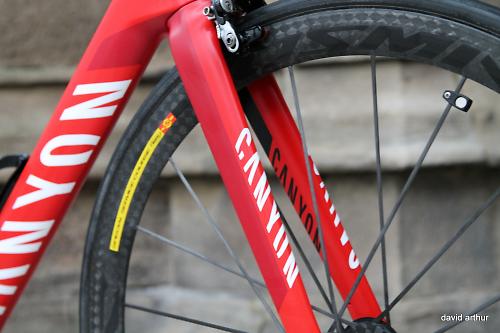

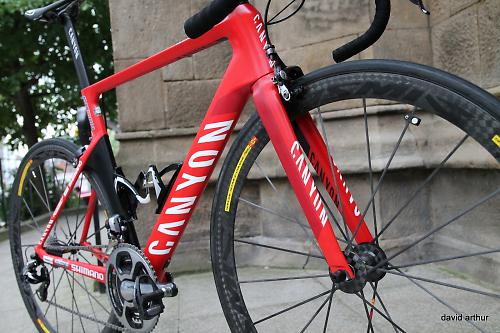

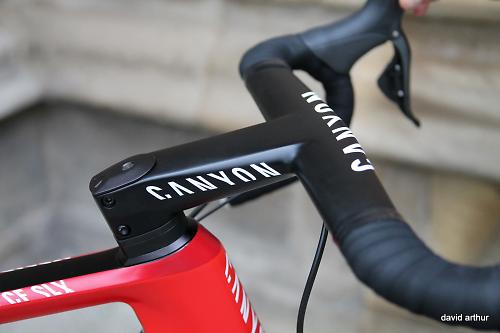
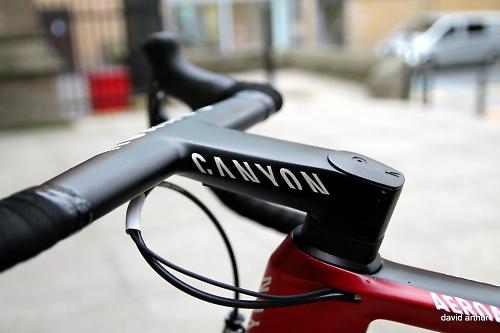
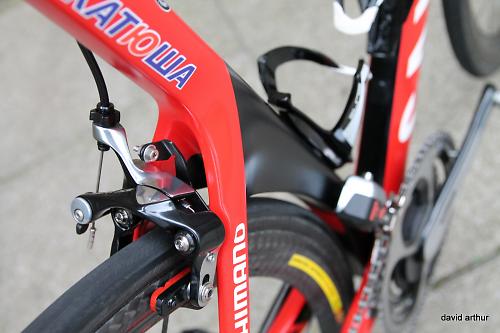

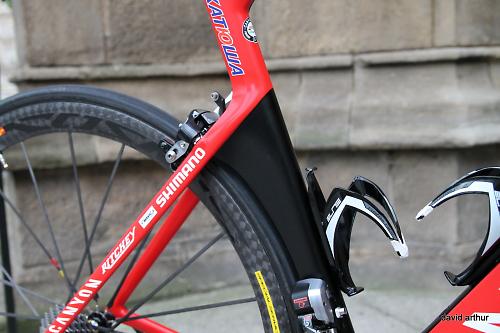
Add new comment
10 comments
I think that bar/stem combo looks splendid - I've never been a fan of the whole aheadset exposed bolts semi industrial look.
In fact for an aero road bike, of which so many look a dog's breakfast, I like the look of that as a whole. Dura-ace with SRM chainset doesn't get any less minging with repeated aquaintance though.
What's it weigh, did I miss that?
That's a really beautifully sorted bike. So simple and well-resolved. But I'm very happy with my Ultimate Al 9.0...
@Knightbiker - thanks for sharing, that's a valuable insight on how it can go wrong - most posts re canyon are just raving about them. I'm sure they are very good, but there are always exceptions.
For the record I rave about my canyon but I'll also rave about their customer service, I'd had my bike 6 months when the front mech pivot bolt sheared , took a couple of pics emailed them and told them I'd bought a replacement 105 mech just to keep riding on my hols , instant email back saying either send them the receipt for the mech with my original customers order no of the bike and they would send me a cheque for the mech or simply send the old one back and they would send a replacement (ultegra) ....I took the cheque and it arrived in 2 days
I like the blacked out seat tube section, definitely tricks the eye a bit with the styling.
Any idea why they use the front brake on the rear as well? I don't get what the difference/advantage really is?
Seems like a great upgrade over a great frame that i have used over great effect. I am very happy with the current frame's ride characteristics, rock solid and sturdy, best frame i ever had.
But i'm finding out that buying through them indeed has it's drawbacks. The inclusion of local service centre's helps.
But trying to get warranty over a construction error they made in my frame is a very difficult process: they offer crash replacement instead of full warranty while their warranty online still should run till oktober, logically thinking the error can only be made by them but their first reaction was to blame me for the error, but i have gotten them around to taking me serious.
(still buying a frame/bike through a dealer/shop should make warranty a lot easier, but finding the right dealer for other good service is hard also)
So, if you buy from them keep that mind: Make sure the frame has a serial number, mine didn't and that should not have been possible. Make sure you photograph every detail of the frame, especially the bottom bracket/front fork/seatpost.
they don't like you or other bicycle repair shops tinkering/ maintaining your bike/frame which is a real pain because for small repair you don't want to be parted of your bike. Still if you wan't to put your own group on the frame it's best to let them do it.
Also something they failed to mention: the frame isn't really suited for a ultegra triple groupset. (which is getting less common these days so it shouldn't really be a problem for most.)
They way they have been behaving towards me wasn't really something you would call client friendly, blaming me in first instance, for now they are still talking and i'm trying my utterbest to stay friendly also. But the experience isn't really inline with what i expect from their website statements. (if it ends well i will post that here also.)
Nice road bike, carbon bike become the mainstream.
DIY own carbon bike is a very nice thing.
http://www.diy-carbonbike.com/
Seriously interested with one of these to replace my current frame at some point!
A mate has an old aeroad and it's so good.
Should be a steal as well
Nice styling on this thing, and being a Canyon I'm sure it'll be a great bike at a great price. Still the same Canyon bugbears as ever though; No US distribution and no way to try before a purchase coupled with a business model that condemns your local bike shop.
That's the thing with Canyon - one of the reasons they can offer great bikes at great prices is because there are no bike shop owners in the middle needing to make a profit. Without that model, they wouldn't be so competitive on price.
I'd imagine it won't be too long before they get to the US market directly. It's a big market to ignore, and when their growth in Europe starts to slow I'm sure they'll open up there too.